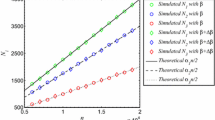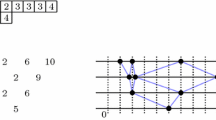Abstract
Magnus’ Freiheitssatz [20] states that if a group is defined by a presentation with m generators and a single cyclically reduced relator, and this relator contains the last generating letter, then the first \(m-1\) letters freely generate a free subgroup. We study an analogue of this theorem in the Gromov density model of random groups [14], showing a phase transition phenomenon at density \(d_r = \min \{\frac{1}{2}, 1-\log _{2m-1}(2r-1)\}\) with \(1\le r\le m-1\): we prove that for a random group with m generators at density d, if \(d < d_r\) then the first r letters freely generate a free subgroup; whereas if \(d > d_r\) then the first r letters generate the whole group. This result partially answers a general problem proposed by Gromov in 2003 [15]: existence/nonexistence of non-free subgroups in a random group.












Similar content being viewed by others
Data availability statement
No data was used for the research in the article.
References
Antoniuk, S., Łuczak, T., Świa̧tkowski, J.: Random triangular groups at density 1/3. In: Compositio Mathematica 151.1. pp. 167–178. London Mathematical Society (2015). https://doi.org/10.1112/S0010437X14007805
Arzhantseva, G.N.: On groups in which subgroups with a fixed number of generators are free (Russian). Fundam. Appl. Math. 3(3), 675–683 (1997)
Arzhantseva, G.N.: Generic properties of finitely presented groups and Howson’s theorem. Commun. Algebra 26(11), 3783–3792 (1998). https://doi.org/10.1080/00927879808826374
Arzhantseva, G.N.: A property of subgroups of infinite index in a free group. Proc. Am. Math. Soc. 128(11), 3205–3210 (2000). https://doi.org/10.1080/00927879808826374
Arzhantseva, G.N., Ol’shanskii, A.Y.: The class of groups all of whose subgroups with lesser number of generators are free is generic. Math. Notes 59(4), 350–355 (1996). https://doi.org/10.1007/BF02308683. (ISSN: 1573-8876)
Bassino, F., Nicaud, C., Weil, P.: Random presentations and random subgroups: a survey. In: Complexity and Randomness in Group Theory. GAGTA Book 1. de Gryuter (2020). https://doi.org/10.1515/9783110667028
Bowditch, B.H.: Notes on Gromov’s hyperbolicity criterion for pathmetric spaces. In: Group Theory from a Geometrical Viewpoint. de Gryuter (1991). https://doi.org/10.1142/1235
Calegary, D., Walker, A.: Random groups contain surface subgroups. J. Am. Math. Soc. 28(2), 383–419 (2015). https://doi.org/10.1090/S0894-0347-2014-00802-X
Champetier, C.: Petite simplification dans les groupes hyperboliques. Annales de la Faculté des sciences de Toulouse: Mathématiques. 6th ser. 3(2), 161–221 (1994). https://doi.org/10.5802/afst.778
Collins, D.J., Huebschmann, J.: Spherical diagrams and identities among relations. Mathematische Annalen 261, 155–183 (1982). https://doi.org/10.1007/BF01456216
Coornaert, M., Delzant, T., Papadopoulos, A.: Géométrie et théorie des groupes : les groupes hyperboliques de Gromov. Lecture Notes in Mathematics, vol. 1441. Springer, Berlin (1990)
Ghys, E.: Groupes aléatoires (d’après Misha Gromov, . . . ). In: Astérisque 294 (2004), pp. viii, 173–204. https://doi.org/10.1090/S0894-0347-2014-00802-X
Gromov, M.: Hyperbolic groups. In: Essays in Group Theory. Mathematical Sciences Research Institute Publications, vol. 8, pp. 75–263. Springer, New York (1987). https://doi.org/10.1007/978-1-4613-9586-7_3.
Gromov, M.: Finitely presented groups. In: Asymptotic invariants of infinite groups. Geometric Group Theory. Vol. 2. London Math. Soc. Lecture Note Ser. 182, 269–282 (1993). https://doi.org/10.1017/CBO9780511629273
Gromov, M.: Random walk in random groups. Geom. Funct. Anal. 13(1), 73–146 (2003). https://doi.org/10.1007/s000390300002
Guba, V.S.: Conditions under which 2-generated subgroups in small cancellation groups are free. Izvestiya Vysshikh Uchebnykh Zavedenii. Matematika 87(7), 12–19 (1986)
van Kampen, E.R.: On some lemmas in the theory of groups. Am. J. Math. 55(1), 268–273 (1933). https://doi.org/10.2307/2371129
Kapovich, I., Schupp, P.: On group-theoretic models of randomness and genericity. In: Groups, Geometry, and Dynamics, Vol. 2.3, pp. 383–404. ISSN: 1661-7207 (2008). https://doi.org/10.4171/GGD/45
Roger, C.: Lyndon and Paul E. Springer-Verlag, Schupp. Combinatorial Group Theory (1977)
Magnus, W.: Ueber diskontinuierliche Gruppen mit einer definierenden Relation (der Freiheitssatz). Journal für die reine und angewandte Mathematik 163, 141–165 (1930)
Margolis, S.W., Meakin, J.C.: Free inverse monoids and graph immersions. Int. J. Algebra Comput. 3(1), 97–100 (1993). https://doi.org/10.1142/S021819679300007X
Ol’shanskii, A.Y.: Geometry of Defining Relations in Groups. Springer Science+Business Media, Dordrecht (1991). https://doi.org/10.1007/978-94-011-3618-1
Ollivier, Y.: Sharp phase transition theorems for hyperbolicity of random groups. Geom. Funct. Anal. 14(3), 595–679 (2004). https://doi.org/10.1007/s00039-004-0470-y
Ollivier, Y.: A January 2005 invitation to random groups. Ensaios Matemáticos 10, 1–100 (2005). https://doi.org/10.21711/217504322005/em101
Ollivier, Y.: Some small cancellation properties of random groups. Int. J. Algebra Comput. 17(1), pp. 37–51. World Scientific Publishing Co. (2007). https://doi.org/10.1142/S021819670700338X
Papasoglu, P.: An algorithm detecting hyperbolicity. In: Geometric and computational perspectives on infinite groups. In: DIMACS Series in Discrete Mathematics and Theoretical Computer Science, Vol. 25. American Mathematics Society, pp. 193–200 (1996). https://doi.org/10.1090/dimacs/025
Short, H.: (ed.) Notes on word hyperbolic groups. In: Group Theory From a Geometric Viewpoint, pp. 3–63. World Scientific Publishing (1991). https://doi.org/10.1142/1235
Stallings, J.R.: Topology of finite graphs. Inventiones mathematicae 71(3), 551–565 (1983). https://doi.org/10.1007/BF02095993.
Tsai, T.-H.: Density of random subsets and applications to group theory. J. Combin. Algebra 6(3/4), 223–263 (2022). https://doi.org/10.4171/JCA/63
Żuk, A.: Property (T) and Kazhdan constants for discrete groups. In: Geometric and Functional Analysis GAFA 13, pp. 643–670 (2003). https://doi.org/10.1007/s00039-003-0425-8
Acknowledgements
I would like to thank my thesis advisor, Thomas Delzant, for his patience and guidance, and for many interesting and helpful discussions on the subject. I am also very grateful to the anonymous referee for his/her thorough review of the manuscript and greatly appreciate the comments and suggestions.
Author information
Authors and Affiliations
Corresponding author
Additional information
Publisher's Note
Springer Nature remains neutral with regard to jurisdictional claims in published maps and institutional affiliations.
Rights and permissions
Springer Nature or its licensor (e.g. a society or other partner) holds exclusive rights to this article under a publishing agreement with the author(s) or other rightsholder(s); author self-archiving of the accepted manuscript version of this article is solely governed by the terms of such publishing agreement and applicable law.
About this article
Cite this article
Tsai, TH. Freiheitssatz and phase transition for the density model of random groups. Math. Z. 303, 65 (2023). https://doi.org/10.1007/s00209-022-03186-2
Received:
Accepted:
Published:
DOI: https://doi.org/10.1007/s00209-022-03186-2




